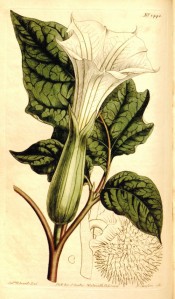Datura metel L.
Datura metel is a frost tender annual species with greenish stems in yellow-flowered plants and purplish in darker forms, and upright, dark purple, blue, white or yellow trumpet-shaped flowers, white to pale violet inside, frequently double or triple, in summer. To 1.5m. [RHSD, Hortus]. Fastuosa has dark foliage and double or triple flowers, purple on the outside, paler within.
The RHSD [1951] commented that Datura fastuosa was perhaps a hybrid of D. cornigera with D. chlorantha but I have not seen this substantiated.
Horticultural & Botanical History
The species was botanically described as Datura metel by Linnaeus in 1853 [Sp.Pl. vol.1, p.179/1753]. He described the purple form as Datura fastuosa in 1859 [Syst.Nat. ed.10, vol.2, p.932/1759.] Datura metel is a variable species and other forms were given specific names by other botanists.
The genus Brugmansia was proposed by Persoon in 1805 to distinguish from the genus Datura the woody, shrubby species with pendulous rather than erect flowers from South America [Syn.Pl. (Persoon) vol.1, p.216/1805]. For some decades these generic names were confused and/or used interchangeably by botanists and nurserymen which probably accounts for William Macarthur’s use of the name Brugmansia fastuosa. This is still used as a horticultural name today although rarely.
All species of the genus Datura contain potent toxic compounds, including powerful hallucinogens and have been used medicinally, and for nefarious purposes, for centuries. ‘The extraordinary narcotic and inebriating effects of these plants has been fully described by the early writers on East-Indian plants; but we have not been able to trace in any of them the practice of smoking the root in the asthma, not very long since introduced to this country from Madras. The first mention we find of this practice is in Loureiro’s Flora Cochin-Chinensis: this author asserts, that the bruised root of the Datura (he considers all the species of Linnaeus as mere varieties, except arborea) smoked through a tobacco pipe speedily relieves violent paroxysms of the asthma.’ [See notes below]. [BM t.1440/1812]. Introduced to Britain in 1596. [JD]. Flore des Serres figures a double white form. [FS f.1457/1859].
History at Camden Park
Grown at Camden since at least 1847 and listed in the 1857 catalogue [T.174/1857]. It was possibly sent as seed from Tahiti by Bidwill and raised by Macarthur at Camden. Two plants of Datura fastuosa were presented to the Sydney Botanic Gardens by William Macarthur on 15th September 1847. [RBGS AB]. Possibly introduced for its medicinal properties.
Notes
An extract of Datura stramonium is the active ingredient of the once popular Potter’s Asthma Remedy. My grandfather, Head Gardener at Alscot Park, outside Stratford-upon-Avon, Warwickshire, was a regular user of the product at a time when mainstream medical assistance was readily available only to the well off. A few cases of toxicity have been recorded, invariably as a consequence of misuse.
Published Feb 27, 2009 - 05:21 PM | Last updated Jun 14, 2011 - 03:31 PM
| Family | Solanaceae |
|---|---|
| Category | |
| Region of origin | Tropics including Australia |
| Synonyms |
|
| Common Name | Horn of plenty, Downy thorn apple |
| Name in the Camden Park Record | Brugmansia fastuosa |
| Confidence level | high |


